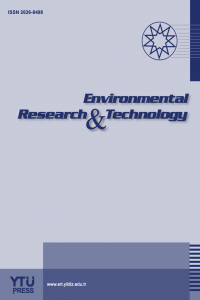Bioremediation of areas devastated by industrial waste
Bioremediation, Paulownia elongate, industrial landfills,
___
- [1]. Zhu, L., Dong, Y., Li, L., Liu, J., & You, S. J. (2015). Coal fly ash industrial waste recycling for fabrication of mullite-whisker-structured porous ceramic membrane supports. RSC advances, 5(15), 11163-11174.
- [2]. Baas, L., Krook, J., Eklund, M., & Svensson, N., (2010). Industrial ecology looks at landfills from another perspective. Regional development dialogue, 31(2), 169-183.
- [3]. Chandra, R., (Ed.). (2015). Advances in biodegradation and bioremediation of industrial waste. CRC Press.
- [4]. Wang, X., Feng, Z., (1995). Atmospheric carbon sequestration through agroforestry in China. Energy, 20(2), pp.117-121.
- [5]. Захаринов, Б., Пейчинова, М., (2014). Биоенергетични и почвено-екологични характеристики на биогаз и биошлам получени в процес на анаеробно разграждане.
- [6]. Haracic, N., Osmanović, Z., Petrovski, P., The usage of alternative materials in cement industry in order to reduce CO2 emissions, 3rd International Conference reserch and Education in natural Sciences, HERTSPO 2015, Proceedings book,Vol. 1., 232–240.
- [7]. Osmanovic, Z., Petrovski, P., Smailhodzic, H., Omerdic Dž., (2008). Effect of Alternative Energents Usage on Cement Production Parameters in the Cement Factory Lukavac. J Environ Prot. Ecol, 9 (1), 119
- [8]. Osmanovic, Z., Haracic, N., & Zelic, J. (2016). Analysis of use of Paulownia elongata as an alternative fuel in the cement industry to reduce emissions of pollutans. XIth Scientific – Research Symposium with International Participation, Metallic and nonmetallic inorganic materials, production–properties–application, Proceedings, Electronic edition, Zenica (B&H).355 – 361.
- [9]. Osmanovic, Z., Cipurkovic, A., Catic, S., & Imamovic, I. (2009). Decreasing pollutant emissions by re-engineering the production process in FC Lukavac. Journal Of Environmental Protection and Ecology, 10(1), 56-64.
- [10].Osmanovic, Z., Haracic N., Avdic N., Development Of Industrial Waste Separation Methodology, Environment and Morals , Proceeding Book, ISEM 2018.,pg. 71-81 .
- [11]. Osmanovic, Z., Huseinovic, S., Bektic, S., & Ahmetbegović, S. (2017). Construction of bioparks on devastated land in urban areas. Periodicals of engineering and natural sciences, 5(1).
- [12]. Huseinovic, S., Osmanovic, Z., Bektic, S., & Ahmetbegovic, S. (2017). Paulownia elongata sy hu in function of improving the quality of the environment. Periodicals of Engineering and Natural Sciences, 5 (2).
- [13]. Osmanović, Z., Osmanović, S., Ahmetbegović, S., Construction of bioparks on devastated land in urban areas, 3rd International symposium on environment and morality, ISEM 2016, Proceedings, Alanya, Turkey, 2016., 1293 – 1299.
- [14]. ISO, DIN. "11466 (1995) " Soil quality-Extraction of trace elements soluble in aqua regia (1999).
- [15]. Frosch, R. A., (1994). Industrial ecology: Minimizing the impact of industrial waste. Physics Today, 47(11), 63-68. [16]. Sims, B. H., Philipp, C. T., (1996). U.S. Patent No. 5,496,392. Washington, DC: U.S. Patent and Trademark Office.
- [17]. Ortega-Calvo, J. J., Posada-Baquero, R., Garcia, J. L., Cantos, M., (2017). Bioavailability of Polycyclic Aromatic Hydrocarbons in Soil as Affected by Microorganisms and Plants. In Soil Biological Communities and Ecosystem Resilience (pp. 305-319). Springer, Cham.
- [18]. Lazăr, G. C. B., Stătescu, F., Toma, D., (2020). Study of Heavy metal dynamics in soil. Environmental Engineering & Management Journal (EEMJ), 19(2).
- Yayın Aralığı: Yılda 4 Sayı
- Başlangıç: 2018
- Yayıncı: Yıldız Teknik Üniversitesi
Juciara LOPES, André ROSA, Izabelle SOUSA, Silas MELO, Antonella ALMEİDA, Alisson BORGES
Halil İbrahim UZUN, Eyüp DEBİK
Samahir A. S. IDRİS, Emel TOPUZ
Zehrudin OSMANOVİC, Nedzad HARACİC, İbrahim SARAJLİC, Amila DUBRAVAC, Eldin HALİLČEVİĆ
Şahin AKPINAR, Hasan KOÇYİĞİT, Fatma GÜRBÜZ, Mehmet ODABAŞI
Burcu KEKEVİ, Ali EŞLEK, Emine Hilal MERT
Simge SERTGÜMEÇ, Ayşe Nur USTA, Cevat ÖZARPA
